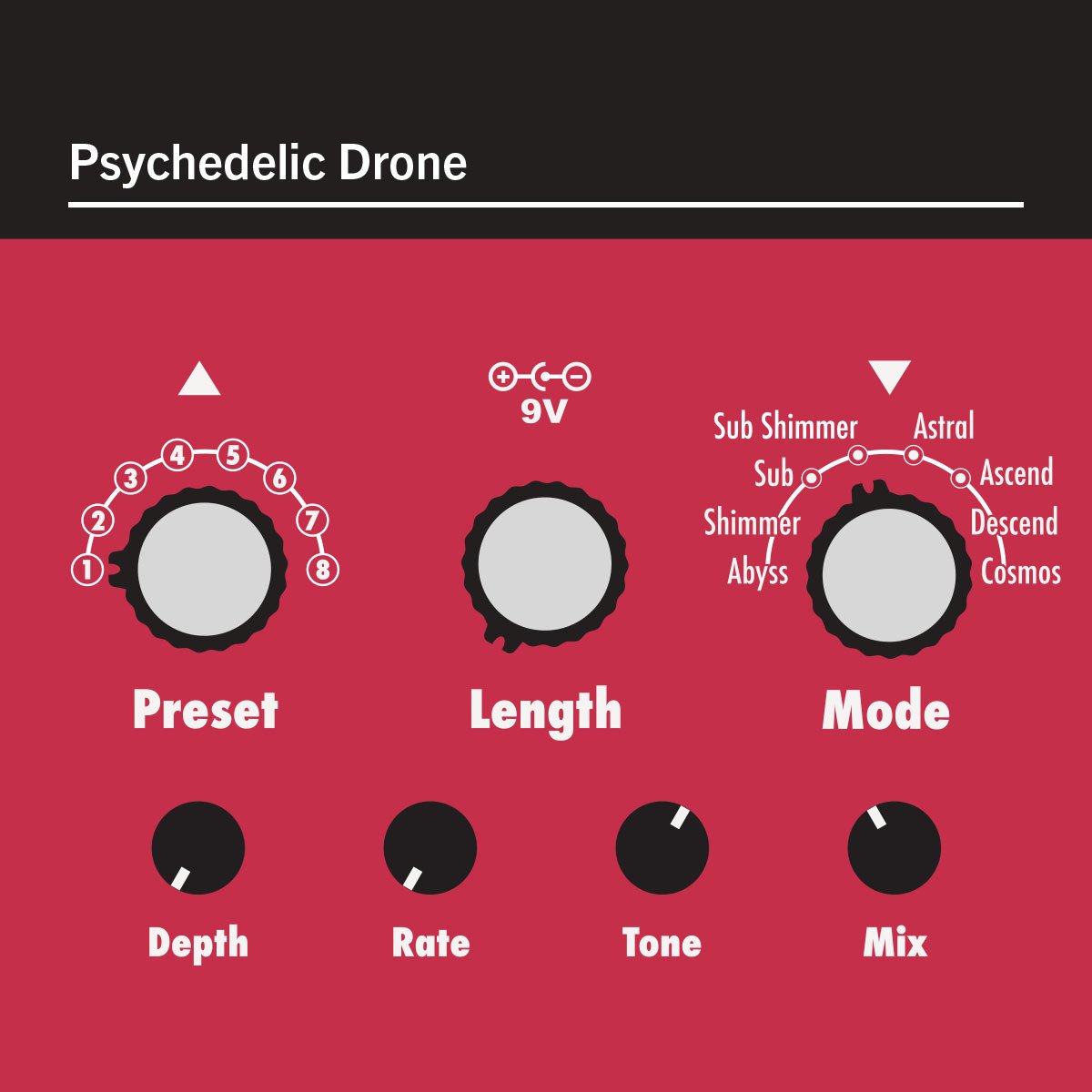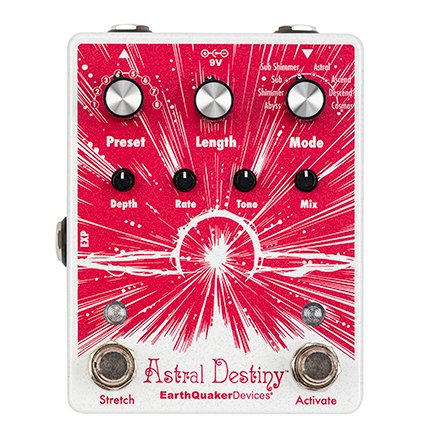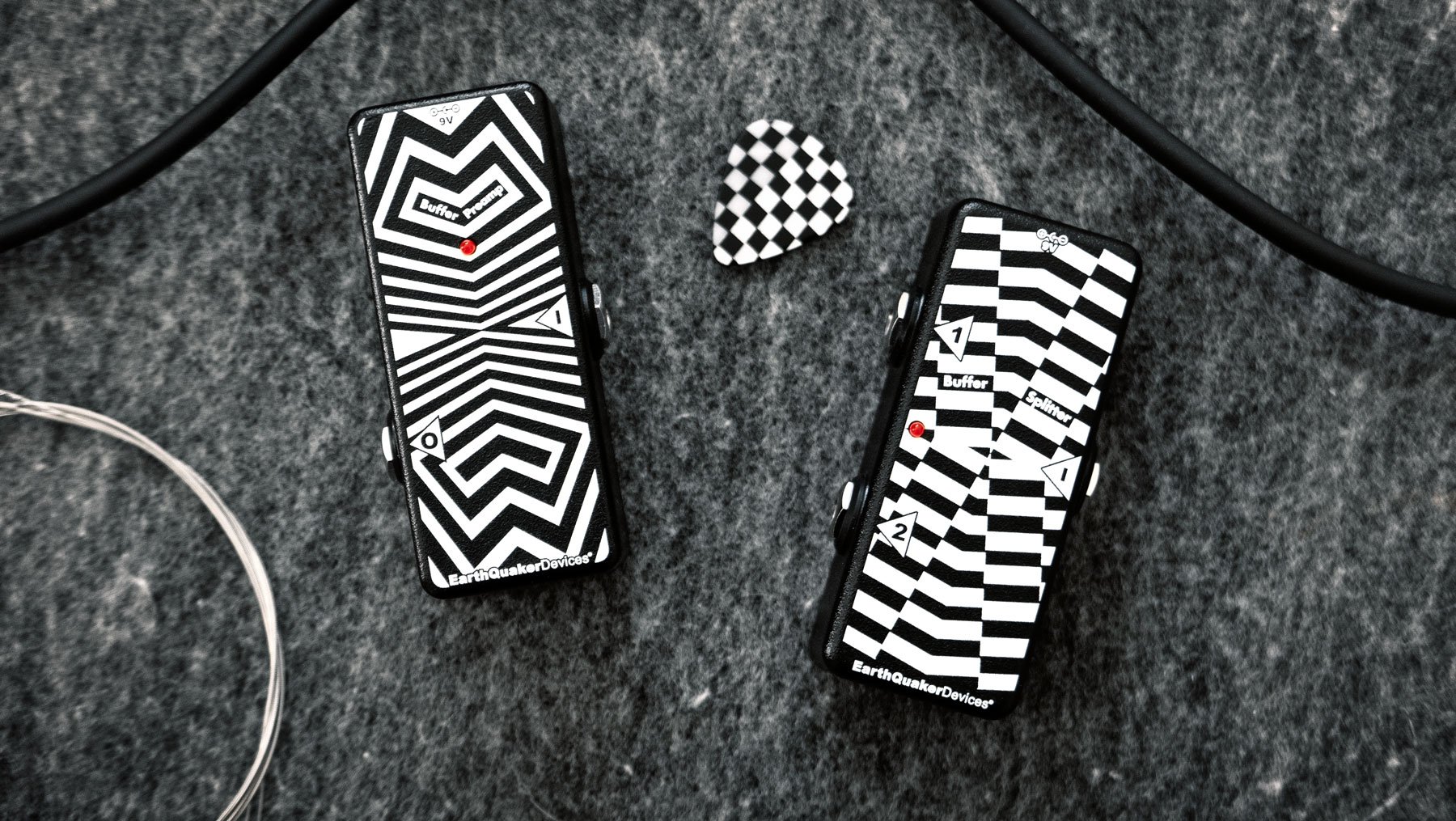The Non-Shoegaze Guitarist’s Guide to Astral Destiny
Dan Epstein
In the two and a half years or so since it first landed on our planet, EarthQuaker Devices’ Astral Destiny octave reverb pedal has helped countless guitarists, keyboardists, drummers and vocalists achieve astral destinies of their own with its cosmic layers of sound and its mind-warping pitch bend functions. If you travel in shoegaze or ambient orbits, the Astral Destiny is an essential tool for your sonic and creative arsenal, thanks to eight different reverb modes, assignable expression control, the reverb-doubling, pitch-bending Stretch switch, and the ability to store up to eight editable presets.
Of course, if you’re an EQD fan, you already know all this. What you probably don’t know, however, is that the Astral Destiny also has the capacity to create truly killer sounds which have nothing at all to do with shoegaze and/or ambient music. Shimmering reverb tails, multi-octave volume swells and towering cathedrals of sound aren’t your thing? No problem — with a little tweaking, the Astral Destiny can still totally take you where you want to go, as these seven awesome settings will loudly attest!
Surf
It’s often easier to shoot the curl without wiping out than it is to get a good spring reverb sound out of a digital pedal. So I was pleasantly surprised to discover that the Astral Destiny can deliver a deliciously glassy yet surprisingly warm reverb, one which sounds totally gnarly when paired with the rapid double-picking and graceful whammy bar bends of classic surf music; palm-muted staccato picking really pops with it, as well.
To channel some tasty waves, first set the Mode control to Abyss, the one reverb mode on the Astral Destiny that doesn’t add an octave or bend the pitch. Dial the Length control to 1 o’clock, which will give you an appropriately long reverb decay. Turn the Depth control all the way up (5 o’clock) while turning the Rate control all the way down (7 o’clock); crank the Tone control to 5 for maximum treble boost; and dial the Mix control to 3 for a nice, wet reverb effect. Then, with a clean amp and your guitar’s treble pickup turned all the way up, try your hand at something like The Astronauts’ “Baja,” or “Pipeline” by The Chantays. You’ll practically be able to smell the salt air!
Spaghetti Western
Create your own theme for an imaginary western using the Astral Destiny’s Sub mode, which adds a lower octave effect to the reverb tail. Set the Length to 3 o’clock for an extended decay; put the Depth at 5, the Rate at 7, and the Tone at 5 for maximum twang. Then set the Mix at 2 for a reverb that’s wide open as a prairie vista but not so cavernous that it’ll spook your horse.
As you pick twangy single-note lines and dramatic partial chords a la Alessandro Alessandroni — the legendary Italian session guitarist who played (and whistled) on Ennio Morricone’s spaghetti western scores — the Sub mode’s low-pitched tails produce a sound that’s similar to a human voice wordlessly echoing the music, perfectly setting the ominous cinematic tone for the impending cowboy showdown of your dreams.
Leslie
The Astral Destiny’s built-in chorus makes it easy to achieve the sort of “rotating speaker” effect that guitarists originally coaxed from Leslie cabinets back in the 1960s. With the pedal in Abyss mode, dial the Length setting back to 9 o’clock to keep the decay from getting in your way, then set both the Depth and Rate to 1 o’clock for a pronounced (but not too pronounced) chorus sound. Set the Tone to 1 o’clock as well, in order to give your notes a slight trebly edge, and set the Mix at 3. Now play some jangly descending or ascending arpeggios, tweaking the Rate as needed to match your picking tempo — and if you want to add a little extra warble and wobble to the proceedings, just tap the Stretch switch!
Cool Jazz
If you’re into playing soulful jazz a la Wes Montgomery or Kenny Burrell, the Astral Destiny can lend your licks a spacious and atmospheric vibe that makes you sound like you’re grooving away in some stylish after-hours cabaret. Using the Abyss mode, set the Length at 2 o’clock for a tasty decay; crank the Depth up to 5 and the Rate down to 7, then turn the Tone down all the way to 7 for maximum treble cut. Crank the Mix all the way to 5 to really drench your guitar in reverb, activate your guitar’s neck pickup, and you’re ready to thumb some sweet II-V-I octave lines deep into the wee small hours!
Arena Crunch
One of the many wonderful things about the Astral Destiny is how responsive it is to other pedals. Case in point: While using the above “Cool Jazz” setting, I accidentally stepped on my pedal board’s Big Muff clone, and in the process suddenly launched myself from smoke-filled nightclub to smoke-filled basketball arena. By keeping the Astral Destiny in Abyss mode with its Depth at 5 o’clock, the Rate at 7 o’clock and the Mix at 5 — but shortening the Length to 1 o’clock and turning the Tone down to 9 to diminish any harshness — I was able to dial in something that pretty sounded damn close to the overtone-heavy, rafters-slamming sound of Neil Young’s Live Rust attack. You should be able to achieve something similar using any Muff-style dirt pedal. (Might I suggest the EQD Hoof?)
Psychedelic Drone
The Astral Destiny’s Sub Shimmer mode adds an upper and lower octave to the reverb tail, which is an incredibly cool effect when you’re conjuring up majestic washes of sound, though it can be a bit difficult to incorporate into something that’s a little more on the fast and melodic side. But once you tame the Sub Shimmer by keeping most of the pedal’s settings at 12 o’clock or earlier, you can achieve some wonderfully evocative and atmospheric effects without overwhelming anything that you’re playing. For example, I love doing quasi-Eastern psychedelic drones on my D and G or G and B strings; with the right tweaks, the Sub Shimmer mode adds a really cool effect to those drones that sounds almost like orchestral accents. Turn the Length, Depth and Rate effects all the way down to 7 o’clock, and the Mix down to 11 — but set the Tone to 1 o’clock to give your notes a touch of trebly definition — and you’ll be on a flying carpet to the Casbah in no time flat. For an even more exotic effect, try this same setting while droning in modal tunings like DADGAD or CGCGCD.
Jangle Pop
Another wonderful-but-underrated aspect of the Sub Shimmer mode is how it can subtly beef up open chords and arpeggios by adding upper and lower octaves to the reverb tails. Again, incorporating this effect into your sound simply requires that you tone it down a bit; just set the Length at 12 o’clock, turn both the Depth and Rate all the way down to 7, and dial both the Tone and Mix down to 10. Whether you’re going for Byrds-y jangle, ‘80s-style indie strumming or even meditative chordal passages a la mid-period Led Zeppelin, this setting will instantly make your cleanly-picked and -strummed chords sound bigger, richer and shinier without any obvious artificial sonic enhancements creeping in.
Dan Epstein is an author, editor, journalist and guitarist based in New York's Hudson Valley. He writes about his latest musical obsessions at Jagged Time Lapse, and songs from his latest musical project The Corinthian Columns can be found at corinthiancolumns.bandcamp.com













